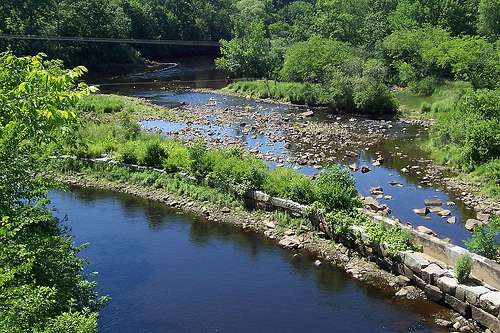 Start with this dam thing on the Great Works River.Photo: InAweOfGod’sCreationHere at Grist we love infrastructure, from fixing it, to expanding it, to coming up with creative ways to reuse it. Over at The Atlantic, writer Paul Greenberg (of Four Fish fame) touts another alternative: tearing it down. Specifically, Greenberg argues for dismantling the long-standing network of prominent river dams that have far outlived their usefulness.
Start with this dam thing on the Great Works River.Photo: InAweOfGod’sCreationHere at Grist we love infrastructure, from fixing it, to expanding it, to coming up with creative ways to reuse it. Over at The Atlantic, writer Paul Greenberg (of Four Fish fame) touts another alternative: tearing it down. Specifically, Greenberg argues for dismantling the long-standing network of prominent river dams that have far outlived their usefulness.
Throughout the United States, there are tens of thousands of dams that today serve absolutely no purpose whatsoever. Most of them were built on streams and rivers during the Industrial Revolution, providing mechanical hydropower to textile mills and other private manufacturers, primarily in the Northeast. But as manufacturing moved away from New England during the 20th century, many of the companies that built and maintained these dams went bankrupt. Unfortunately, when they closed up shop they left their stream barriers in place.
While these dams were once a way of building up the American economy, today they represent a tremendous force pulling it down. Dams, even when they no longer serve industry, continue to do one pernicious thing very effectively: block the passage of fish to and from the sea.
If this sounds familiar, it’s because the Clinton administration began a dam-destroying campaign back in the ’90s (you know, back when anything seemed possible!). That effort led to the dismantling of 430 dams since 1999, according to this New York Times 2009 editorial.
Greenberg makes a strong argument in favor of getting rid of non-power-generating dams in the Northeast — and not just because it would restore salmon runs (up to 40,000 10- to 30-pound Atlantic salmon ran the Connecticut River before being dammed into extinction 200 years ago). His larger point is that it would help the fish that help maintain our commercial fisheries:
… [S]almon represent just a tiny percentage of the sea-run, or “diadromous,” fish that could be recovered should non-power-producing dams be removed. Principal to river ecosystems are shad, eels, alewives, and other smaller fish that yearly make the run either from salt to fresh or fresh to salt. These “forage” fish are the short-term credit of marine ecology. Practically everything eats them, from delicious white-fleshed striped bass to tasty summer flounder to thousand-pound bluefin tuna. Remove them from the ecosystem, and you are depriving the fish we love most of their best source of protein. Return them, and you have the potential to increase the biotic wealth of the ocean profoundly. Imagine the value to the American economy of a fisheries sector producing surpluses rather than running deficits.
He posits his anti-dam campaign as an excellent use of the few stimulus dollars still working their way into the economy. I should point out Tom Philpott put out a call back in 2009 for food-system stimulus ideas. Where were you then, Paul? Better late than never, I suppose.
Dam removal isn’t just for fish. Greenberg quotes a Connecticut state official who refers to these centuries-old dams as “ticking time bombs” susceptible to destruction by powerful hurricanes, which are happening more often in our warming climate. Taking these dams down would actually improve public safety. Given all the challenges facing our Atlantic fisheries of late, doing a little “spring” cleaning (spring = river … get it? Ha.) seems like a good idea.



